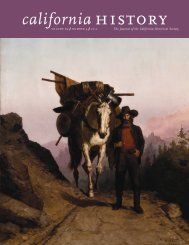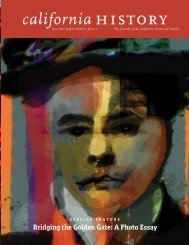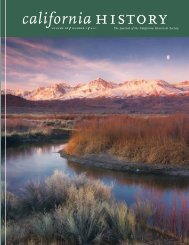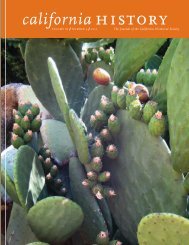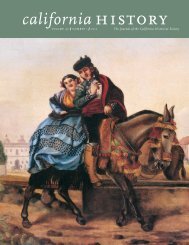and illegal drug use in the park. The former concernignored the fact that the university would beequally liable for the soccer field; the latter disregarded,even after the petition grew to 132, aneven larger number of area residents who alreadyhad shown their support. Seventy-four Collegeof Environmental Design students subsequentlyconducted a public opinion poll, which revealedthat 81 percent of residents in a thirty-five-squareblockarea surrounding the park favored anothercompromise proposal by William Wheaton, deanof the college: lease the land to a nonprofit corporationand allow it to be developed as a communitypark. 36William J. McGill, chancellor at the Universityof <strong>California</strong>, San Diego, thought that Heynshad missed one “window of opportunity” bynot quickly asserting university property rightsand a second by rejecting the possibility of compromise.By May 8, “with literally thousandsof protagonists determined to defend People’sPark,” McGill believed that Heyns’s best optionwas to cooperate with the concept of the park,even if only as “some form of temporary compromisewhile waiting for natural antagonismsamong the factions to split the group apart.” Itappeared to McGill that although Heyns initiallyhad favored compromise, he had spurned Vander Ryn’s proposal in fear of the need to defendany concessions to Governor Reagan and theRegents at an approaching May 16 meeting.The Regents, according to McGill, had alreadymade it quite clear that “a user-developed, usermaintainedpark was unacceptable to a majorityof the board, and especially the Governor’s supporters.”Heyns, after placing a phone call to Vander Ryn on the night of May 11, had practicallyacknowledged as much. He told Van der Ryn:“You’ve done your best, but it won’t fly.” Van derRyn then urged Heyns, as the chancellor of “aneducational institution committed to experimentationand student involvement,” to “take someleadership” and intervene in favor of the park.Heyns brusquely replied: “Look, I’m just a janitorfor the Regents.” 37Had Heyns accepted Van der Ryn’s compromise,he could have defended his position by arguingthat he had preserved the necessary land forthe urgently needed soccer field while removingradical operation of People’s Park and placing itunder university control through the College ofEnvironmental Design. Then, if conflict flared,Heyns could cancel the entire project and blameradical activists for failing to cooperate with theuniversity’s efforts to negotiate a workable compromise—aposition that probably would havedriven a wedge between the founders of People’sPark and the nonradicalized students, weakeningtheir coalition.Instead, on May 13, a day following his departurefor a meeting of the National Science Foundationin Washington, D.C., Heyns released a statementasserting that, after realizing People’s Parkwas only “a ploy to create a new confrontationbetween students and the University,” he had “nofeasible alternative except to fence the area.” Vander Ryn, whose initial contact with the park developershad been the radical Big Bill Miller, stillbelieved that People’s Park reflected the peacefulvalues of the counterculture rather than the confrontationalattitudes of political activists: “Radicalpolitical groups did try to use the park issue fortheir own ends, but they were largely ignored bythe majority of the ‘new culture’ people.” 38The park’s founders certainly included severalpolitical radicals who delighted in provokingconfrontations with the university. One of them,Art Goldberg, even publicly professed his pleasureover placing Heyns in a no-win situation:“The university is in a very difficult situation. If itmoves its bulldozers on a nearly completed park,it will arouse the wrath not only of the youngpeople and the radicals, but it will also disappointthe liberals and expose its true expansionist<strong>California</strong> History • volume 88 number 1 2010
nature. If it allows the park to exist, it knows ithas on its doorstep a center for the type of activitythat it despises.” Stew Albert, from his more hipradicalperspective, also foresaw two possible outcomes:at once viewing the park as “such a gentlething” that it virtually invited “co-optation” byuniversity authorities, but also recognizing thatGovernor Reagan, who had campaigned to “cleanup the mess at Berkeley,” might be “sucked intoa fight” over the issue. 39By declaring that there was “no feasible alternative”simultaneously with Van der Ryn’s compromisesolution, Heyns assured continued supportfor People’s Park from a broad-based coalitioncomposed of the original founders, faculty sympathizers,and nonradicalized students, includingrepresentatives of student government andmembers of sororities and fraternities who hadparticipated in building the park as one of theircommunity improvement projects. The chancellorhad failed at a hard-line strategy by not actingswiftly enough, at compromise by not acknowledgingits potential, and at diluting oppositionby not fragmenting the diverse People’s Parkalliance. Completing the process, he passed universitysupervision over the fence construction tothe police on May 15, 1969—“Bloody Thursday,”as it became known to park supporters. 40Act III: Bloody ThursdayNeither Chancellor Heyns nor Vice-ChancellorCheit was in Berkeley on Bloody Thursday.Heyns, prior to departing on May 12 for theNational Science Foundation meeting, had persuadedCheit to substitute for him at the May 16Regents meeting in Los Angeles. Heyns hadleft word for the fence to be constructed in hisabsence and had contacted the Alameda Countysheriff to provide protection for constructionworkers. However, he neglected to tell his secondvice-chancellor, nominally next in campus command,about the fence construction project. 41The oversight left the head of campus police,Captain William Beall, as the only universityofficial with any real conception of events as theytranspired during that momentous Thursday.Beall, however, was subordinate to the man whobecame Berkeley’s military commander for theday: Alameda County Sheriff Frank Madigan. Asixty-one-year-old alumnus of the FBI NationalAcademy and a winner of the <strong>California</strong> AmericanLegion award for “untiring zeal” in narcoticslaw enforcement, Madigan had served theAlameda County Sheriff’s Department since1932, the last seven as sheriff. He blamed theentire People’s Park controversy on “anarchistsand revolutionaries” who wanted “to take thisform of government down, starting with theeducational system and then with law enforcement.”Such a personal animus undoubtedlyaffected his actions. Earlier in February 1969,during a student strike in Berkeley organized bythe Third World Liberation Front over demandsfor minority studies programs, Governor Reaganhad declared a “state of extreme emergency” andauthorized the use of Bay Area and state policeon campus. Now, a few months following thestrike, the governor’s decree remained in force. 42The tragedy of Bloody Thursday began at dawn,4:45 a.m., when Madigan directed 250 policemen—includingmembers of the AlamedaCounty Sheriff’s Department, the San FranciscoTactical Force, Berkeley police, the <strong>California</strong>Highway Patrol (CHP), and campus police—toevict seventy defenders of the park who hadcamped there overnight. By noon, some 2,000to 3,000 park supporters had gathered on campusat Sproul Plaza. Following several speakers,student body president-elect Dan Siegel took themicrophone. A second-year law student who livedonly a block away from People’s Park, Siegel laterrecalled speaking “very generally although heatedly”and then spontaneously exhorting, “Let’s godown there and take the park.” This idea strucksuch a popular chord with those assembled that,1
- Page 3: california historyvolume 88 number
- Page 6 and 7: c o l l e c t i o n sAdmission tick
- Page 8 and 9: c o l l e c t i o n sBusiness cards
- Page 10 and 11: People’s Park:Birth and SurvivalB
- Page 12 and 13: even on existing dorms due to the h
- Page 14 and 15: The attraction, however, was fleeti
- Page 16 and 17: Bay Area—North Beach and Haight-A
- Page 18 and 19: A hundred students, activists, and
- Page 20 and 21: are building a park on the land. We
- Page 24: without even allowing Siegel to con
- Page 27 and 28: As Bloody Thursday came to a close,
- Page 29 and 30: this state.” On June 20, Reagan t
- Page 31 and 32: Denovo, her autopsy revealed a down
- Page 33 and 34: ation and encouragement, and shed n
- Page 35 and 36: the guardians of her children. The
- Page 37 and 38: mitted to visit Caroline in her new
- Page 39 and 40: Sojourner Truth gave what famously
- Page 41 and 42: After emancipation, she helped to o
- Page 43 and 44: This 1885 view captures the sparsel
- Page 45 and 46: But Caroline thought it imprudent t
- Page 47 and 48: The “Mother of Clubs”In Boston,
- Page 49 and 50: Caroline attended the September 189
- Page 51 and 52: ments, Seymour and Sibley earned pe
- Page 53 and 54: In this photograph, San Francisco s
- Page 55 and 56: n o t e s12People’s Park: Birth a
- Page 57 and 58: 1969; McGill, The Year of the Monke
- Page 59 and 60: that “thousands of the brightest
- Page 61 and 62: For Both Cross andFlag: Catholic Ac
- Page 63 and 64: d o n o r sThe California Historica
- Page 65 and 66: In Kind DonationsSandy Alderson, Sa
- Page 67: Membership BenefitsJoin tHeCaliforn



